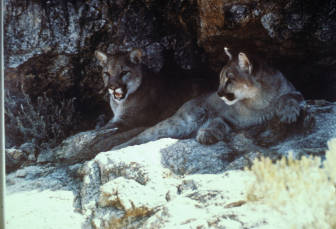
Courtesy and Copyright Eric Newell, Photographer
In May, 1991, two high school friends and I headed for Thunder Bowl in the Wasatch Range, with skis on our packs. We had a long slog ahead of us.

Then loud and distinct human-like cries halted our stride. The goat stopped, then took one last heart-stopping leap to a narrow ledge.
Trapped from descending further, the goat paced nervously back and forth, peering down 150 feet to the forest floor were we were curiously standing. Another set of eerie cries, amplified by the granite walls, shattered the silence again.

Oreamnos Americanus
Courtesy US FWS, Lawrence S Smith, Photographer
My friends shrugged and started to move again. I dropped my pack in the snow. “Let’s go see what’s making all the racket,” I said.
They wanted to keep moving. I told them I’d catch up soon.
Wearing only a pair of shorts and my hiking boots, 17 year-old me, crept carefully into the aspen grove, making my way towards the base of the cliff in a round-about way, scanning the forest constantly, but I did not see anything. Whatever it was, was gone. So I cut back towards the trail. As I approached two giant boulders resting side by side, I noticed movement on the ground.
I stooped to pick up a tuft of thick white wool and rolled it in my fingers. Mountain Goat wool. Another tuft of wool trundled towards me in the breeze. Goat wool littered the ground ahead of me. I stood up, took a long slow breath, and stepped between the boulders.
A massive cougar crouched over her kill, 20 feet away. Her thick, tan fur could not hide the muscular contours of her shoulders and back. The snow at her feet was red–bright red. The lion looked up. Our eyes locked. Time stopped. I was aware of every single detail of this consummate predator’s yellow eyes.
I was too full of absolute awe and stunned marvel to feel even a remote strand of fear. It remains one of the most beautiful things I have ever seen. One or two seconds passed. That is all.
There was a blur of silent movement, a glimpse of hind legs and a long tail flung high in the air, and a thrashing of brush. The cougar was gone.
My attention shifted to the crumpled newborn mountain goat on the ground in front of me. Steam rose from the pooled blood on the miniature ribcage. The little goat’s wool was pure white and contrasted with jet-back hooves and eyes.
The prints in the snow told the story. The cougar circled the newborn prey, slowly decreasing her radius. I imagine her head low, beneath shoulder blades oscillating in slow motion, and eyes laser focused. The two-week-old goat turned in an even tighter circle, letting out a series of cries, as the mother goat paced helplessly, watching from the narrow ledge above. A lethal pounce from the cougar synchronized with the final cries of the little goat—the cries we heard from the trail.

Courtesy US FWS
Larry Moats, Photographer
At that moment I came to my senses. I realized I needed to leave and not interfere with the cycles that were in motion. I turned and walked back towards my pack on the trail, then hurried to catch my friends—glancing over my shoulder from time to time—all the while thinking about those piercing yellow eyes.
I’m Eric Newell and I am wild about Utah’s wild public lands
Credits:
Images: Lone Peak Wilderness Courtesy and Copyright Eric Newell, Photographer
Mountain Goat with Kid, Courtesy US FWS, Lawrence S Smith, Photographer, https://images.fws.gov/
Mountain Lion, Courtesy US FWS, Larry Moat, Photographer, https://images.fws.gov/
Featured Audio: Courtesy & © Anderson, Wakeman and Howe.
Text: Eric Newell, Edith Bowen Laboratory School, Utah State University
Additional Reading: Eric Newell
Additional Reading
Wild About Utah Pieces by Eric Newell
Shughart, Hilary, Mountain Lions Are Keystone Providers for Birds!, Wild About Utah, May 1, 2023, https://wildaboututah.org/mountain-lions-are-keystone-providers-for-birds/
Leavitt, Shauna, Cougars in Utah, Wild About Utah, October 7, 2019, https://wildaboututah.org/cougars-in-utah/
Greene, Jack, My Cougar Encounter, Wild About Utah, January 16, 2017, https://wildaboututah.org/my-cougar-encounter/
Strand, Holly, Mountain Lion, Wild About Utah, March 4, 2010, https://wildaboututah.org/mountain-lion/
Mountain Lion or Courgar – Puma concolor, Fieldguide, Utah Division of Wildlife Resources, https://fieldguide.wildlife.utah.gov/?species=puma%20concolor
What to do if you encounter a mountain lion in Utah, Utah Division of Wildlife Resources, May 21, 2024, https://wildlife.utah.gov/news/utah-wildlife-news/1906-what-to-do-if-you-encounter-a-mountain-lion-in-utah.html







